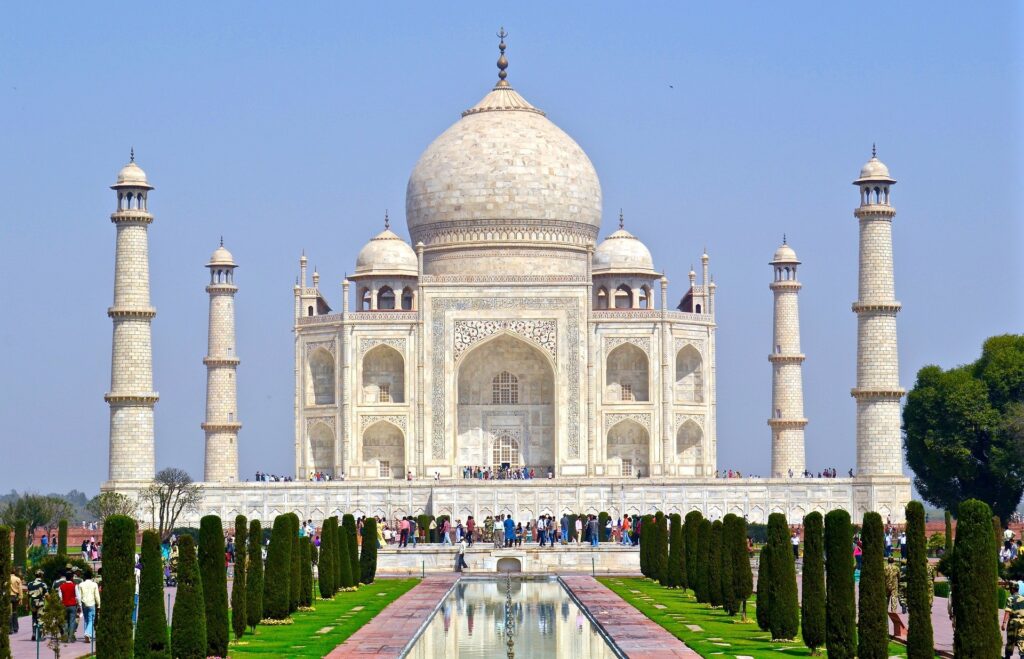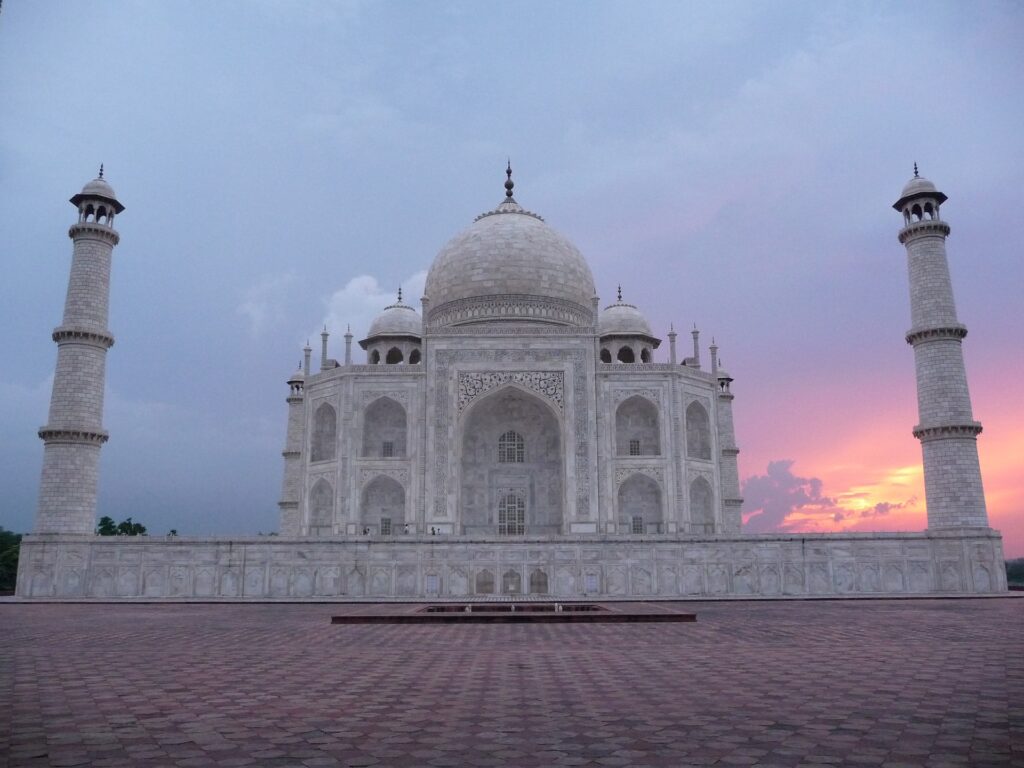In this essay we are going to talk about the Taj Mahal. India, a land rich in cultures, religions and traditions. A country with a vast and vivid history. A place, full of beliefs, customs and traditions. India is a country that holds unity in its diversity. This diversity had its integration with time. When we look through the rich history of the country, we will find glimpses of kings and emperors ruling over the country and Britishers colonising the country for years. This has played a big role in the acceptance and practising of a wide range of cultures and traditions.
Short Essay On Taj Mahal
Kings and emperors did rule over the country and its memories are still fresh as proudly standing monuments and architectures. The unique and innovative artistry and structure showcase the deep interest in architecture and art. Walls of beautiful monuments scream talents of various artists and labourers indulged in it. One of such famous, beautifully crafted art is the mausoleum called the Taj Mahal.
What is the Taj mahal?
Taj Mahal, a 17th-century mausoleum started its construction in 1632 AD. By 1648, it was completed with the mosque, guest house and southern gateway which in later years was accompanied by courtyards. Presently, it is located in the district of Agra, Uttar Pradesh, India. Its impeccable showcase of mutual architecture makes it one of the seven wonders of the world. Every year, millions of visitors and tourists from all around the world come to imbibe and admire its sheer beauty! However, it is not just its architecture that attracts visitors! The story behind the making of the Taj Mahal is heart-melting! The Taj Mahal was built by Emperor Shah Jahan in remembrance of his beloved wife Mumtaz. This white marble mausoleum is a heartwarming and mesmerising representation of undying love.

The love story
The mausoleum of the Taj Mahal was named after Mumtaz mahal who happened to be Shah Jahan’s wife. It is said that Shah Jahan, known as Prince Khurram at that time, happened to encounter Mumtaz or Arjumand Banu Begum in Meena Bazaar. He was 14-year-old when he fell at first sight with the Persian princess ( Mumtaz). Shah Jahan, mesmerized by her beauty, proposed his interest in marrying her in front of his father. After a few years, they ultimately got married to each other.
Mumtaz was known as the ‘Jewel of the Palace’. Even though the emperor did have many wives, Mumtaz was considered his favourite one. She also used to take part in military and administrative affairs.
However, their love story took a tragic turn in 1631, when Mumtaz died while giving birth to their 14th child.
Click Here: Interesting Articles To Read When Bored
On her deathbed, he promised his wife to never marry anyone again. He also promised her a monument. After Mumtaz’s death, Shah Jahan was heartbroken. The court mourned for over 2 years. He started building the Taj mahal by bringing all the artisans from places like Iran and Asia. In the last years of Shah Jahan, his son Aurangzeb took over the throne and kept him under house arrest. After Shah Jahan’s death, his tomb was placed beside Mumtaz’s.
One interesting fact to note about this is that several other theories revolve around their story. One of them, for example, is that some people believe Shah Jahan has chopped off the hands of all the artisans and workers involved in the construction of the Taj so that they can never construct any other monument as beautiful as this. However, this theory doesn’t hold any proof or evidence, thus making it baseless.
The architecture
The 17 hectares occupying Taj mahal is located on the banks of the river Yamuna. The mausoleum is a perfect embodiment of Islamic architecture with hints of Indian, Persian, Ottoman and Turkish architecture. Ustad-Ahmad Lahori was the main architect of this mausoleum. The monument has a satisfying contrast and combination of various solids, arches, shapes, domes and Arabic Quran inscriptions written over it, making it an extraordinary piece of work.
One of the most distinctive features of this mausoleum is that, unlike other forts and monuments, it is not placed exactly at the centre of the garden, rather, it is placed at one end of the garden which further beautifies its view for the spectators.
The tomb consists of a chamber in the centre surrounded by portal halls and corner rooms. The marble of the tomb is decorated with beautiful stones which enhances its appearance. The monument is raised by a stage and is surrounded by four minarets at a reasonable distance. The materials used for its construction are brick(mixed with lime), red sandstones, stones and Makrana marbles.
Read Also: Short Essay On Holi
Maintenance and Management
The physical condition of the mausoleum and its materials are constantly monitored and its way of architecture is studied. The recent increase in air pollutants has led to various deteriorations in the monument. Conditions like the yellowing of marbles are becoming evident over time. To control and manage such secretory effects, various steps have been taken. There are various regulations kept by the government which includes protection of these monuments and such tourist places. One of them is the Ancient Monument and Archaeological Sites and Remains Act, 1958. In 1996, the government of India banned the banned coal industries which come near the Taj Trapezium Zone. Taj Trapezium Zone (TTZ) includes 40 monuments with 3 world heritage sites, out of which, Taj Mahal is one. There is a certain amount of funds approved by the government which goes into maintaining these monuments.
Conclusion
Over the years, the Taj Mahal has become one of the most famous tourist spots in India. Every year, millions of tourists and visitors come to admire the mausoleum, hence, it becomes a necessity to manage the monument so that its beauty won’t be hampered in any way. With the alarming increase in air pollutants, the government has taken major steps to prevent its degradation. It is necessary to closely monitor and study the monument so that we can be aware of and prevent any unwanted changes!! The aesthetically, history-rich beauty is after all worth to be treasured!!
Read Also: Short Essay On Poverty in India
Frequently Asked Questions
- Name India’s three World Heritage Sites?
Three sites of India are included in World Heritage Sites. They are Taj Mahal, Agra Fort and Fatehpur Sikri.
- Mention some of the interesting facts about the Taj Mahal?
There are a lot of interesting things to know about the Taj Mahal.
- The marble used in the making of the Taj Mahal is called Makrana marble. It is also known as sangemarmar marble. It is white coloured marble.
- The colour of the monument changes during the days, due to the hues and shades used which act with light. It appears pinkish during early mornings, milky white at Moon’s and golden during sunset.
- In 1983, UNESCO bestowed it with the title of World Heritage Site.
- It consists of the tombs of Shah Jahan and Mumtaz.
- More than one thousand elephants were used while constructing the monument.
- Ustad- Ahmad Lahori was the main architect of the Taj Mahal.
- What is the story behind the monument of the Taj mahal?
Taj Mahal represents Shah Jahan and Mumtaz’s undying love. Shah Jahan was the grandson of the great emperor Akbar.14 years old, Shah Jahan initially called Prince Khurram fell in love with Mumtaz while stripping in Meena Bazar. He declared his love for Mumtaz in front of his father and they were married after a few years. When Mumtaz died after giving birth to her 14th child, Shah Jahan constructed the said monument in her remembrance.

- What are the theories that revolve around the construction of the Taj Mahal?
Many theories revolve around Shah Jahan and Mumtaz’s story as well as the construction of the Taj Mahal. Some theories suggest that Mumtaz is not the dutiful wife some claim to be! There is evidence of Mumtaz being involved in administrative works. It was even believed that she was a better player of chess than Shah Jahan. She was said to be involved in bringing Shah Jahan to his throne. However, no strong proof supporting the theory is found till now! Apart from that, there are also claims that Shah Jahan ordered to cut the hands of all the workers and artisans who helped in constructing the mausoleum. However, there is no strong evidence supporting the theory.
Archaeologists have not found any traces of skeleton or other proof that supports the theory. Even after making the Taj Mahal, Shah Jahan rule did have many monuments made which further proves the theory to be pretty much baseless.
- How is environmental degradation affect the mausoleum of the Taj Mahal?
Environmental pollution, especially air pollution is a huge concern to India. It also affects monuments like the Taj Mahal negatively. The acid rain has caused several damages to the building. Not just that, some air pollutants react with the white marble of the Taj slowly turning it yellow, therefore losing its glow and shine. Not just air, even water pollution occurring in the Yamuna river impacts the beauty of the Taj Mahal as it is located on the banks of it.